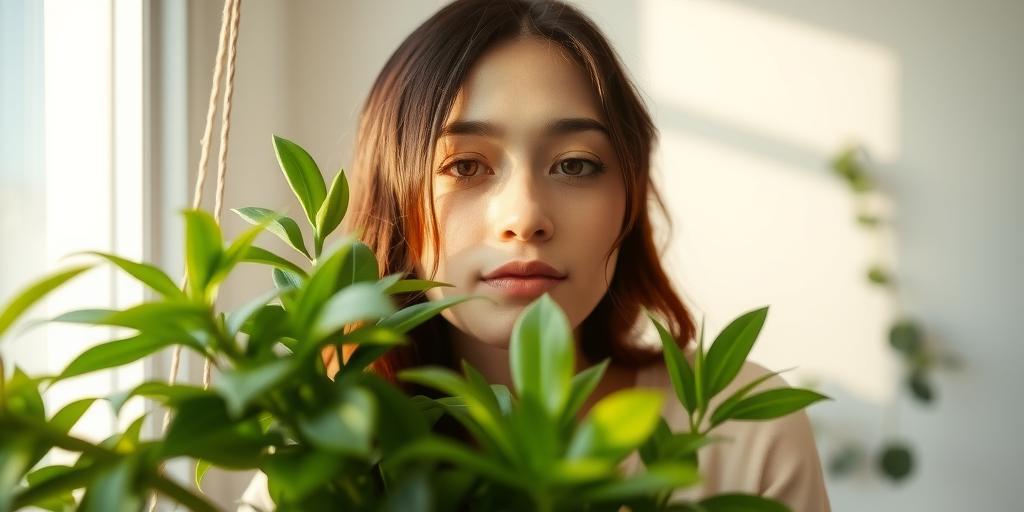
Transform Your Bathroom Oasis: Top Low Light Hanging Plants That Thrive in Humid Bathrooms
Discover the best low light hanging plants for your humid bathroom! Learn which varieties thrive, care tips, and how to create your own lush, spa-like retreat. Perfect for plant lovers of all levels.
Introduction
Is your bathroom a dark, humid space you think is doomed for greenery? Think again! I used to believe that too, until I discovered the incredible world of plants that not only survive but absolutely flourish in these exact conditions. Bathrooms, with their steamy showers and often limited light, create a unique microclimate that mimics the native habitats of many gorgeous trailing plants. In fact, incorporating plants like these can boost your mood and even improve air quality by up to 25%! Get ready to turn that forgotten corner into a thriving, vertical garden. Let’s dive into the perfect plants that will bring life and tranquility to your personal sanctuary.
The Science Behind Humidity-Loving Plants
Have you ever noticed how some plants seem to perk up right after you take a steamy shower? That’s because many tropical species are adapted to absorb moisture directly through their leaves, a process called foliar uptake. In their natural habitats, these plants thrive under forest canopies where humidity is high and direct sunlight is limited. Your bathroom essentially mimics these conditions, providing consistent moisture in the air that allows them to flourish without relying solely on their roots for hydration. This is why your humid bathroom isn’t just a convenient spot—it’s an ideal environment tailored to their needs.
Debunking the Myth: You Don’t Need a Sunny Window
One of the biggest misconceptions about houseplants is that they all require bright, direct sunlight to survive. While some plants certainly do, many popular bathroom-friendly varieties actually prefer indirect or low light. In fact, direct sunlight through a bathroom window can sometimes magnify through water droplets and scorch leaves. Plants like pothos, philodendrons, and ferns have evolved to grow under the shade of larger trees, making them perfectly suited to the softer, filtered light typical of many bathrooms. So, if your bathroom only has a small window or none at all, don’t worry—you still have plenty of options.
How Consistent Moisture Reduces Your Watering Schedule
One of the best perks of keeping plants in your bathroom is how little maintenance they require when it comes to watering. The ambient humidity means the soil takes longer to dry out, reducing the frequency of watering. For many of us who occasionally forget to tend to our plants, this is a game-changer. You might find that your bathroom plants only need water every 10–14 days, compared to weekly or even more often in drier rooms. Just be sure to check the soil moisture before watering to avoid overdoing it—a topic we’ll cover in more detail later.
The Added Benefits: Air Purification and Spa-Like Vibes
Beyond their beauty, plants in your bathroom offer some practical advantages. Many species are natural air purifiers, absorbing toxins and releasing oxygen, which can make your bathroom feel fresher. Additionally, there’s something inherently calming about being surrounded by greenery. Pair that with the steam from your shower, and you’ve created your own personal spa retreat. The aesthetic appeal of trailing plants hanging gracefully can turn a functional space into a serene oasis.
Heartleaf Philodendron: The Undeniable Champion
If you’re new to bathroom plants, the heartleaf philodendron is a perfect place to start. This plant is incredibly adaptable, thriving in low light and high humidity. Its heart-shaped leaves grow quickly, and it trails beautifully from a hanging planter. It’s also very forgiving—if you forget to water it now and then, it’s likely to bounce back without complaint.
Pothos (Devil's Ivy): Virtually Indestructible
Pothos is another excellent choice for beginners and experts alike. Its variegated leaves add a pop of color, and it’s known for being nearly impossible to kill. It tolerates low light, enjoys humidity, and can grow impressively long vines. If you want a plant that looks lush with minimal effort, pothos is your go-to.
Boston Fern: Lush and Feathery
For a classic, elegant look, you can’t go wrong with a Boston fern. These plants crave humidity, making them ideal for bathrooms. Their delicate, feathery fronds create a soft, full appearance, and they’re particularly effective at purifying the air. Just be sure to keep their soil consistently moist (but not waterlogged) for best results.
Spider Plant: Prolific and Easy-Going
Spider plants are famous for their resilience and unique growth habit. They produce “spiderettes”—little offshoots that dangle from the mother plant—which can be propagated to expand your collection. They thrive in humid conditions and can handle occasional neglect, making them a fun and low-maintenance addition.
Peperomia 'Hope': Compact and Charming
If you’re short on space, Peperomia ‘Hope’ is a wonderful option. This trailing plant has succulent-like leaves that store water, reducing its watering needs even further. It loves moisture in the air and adds a touch of green without taking up much room.
String of Hearts: Delicate Yet Tough
Don’t let the dainty appearance of the string of hearts fool you—this plant is surprisingly hardy. Its heart-shaped leaves on thin, trailing stems add a whimsical touch to any bathroom. It enjoys humidity and can tolerate lower light, though it might grow more slowly in these conditions.
Staghorn Fern: Unique and Statement-Making
For something truly distinctive, consider a staghorn fern. This epiphyte naturally grows on trees in the wild, absorbing moisture and nutrients from the air. It can be mounted on a board or hung in a basket, and it loves the steamy environment of a bathroom. Its antler-like fronds make it a fascinating conversation piece.
The Golden Rule of Watering
Even in a humid bathroom, overwatering is the most common cause of plant demise. Always check the soil before watering—stick your finger about an inch deep. If it feels dry, it’s time to water; if it’s still moist, wait a few more days. Well-draining soil and pots with drainage holes are essential to prevent root rot.
Finding the "Bright" in Low Light
While your bathroom might not have abundant sunlight, most plants still need some indirect light to photosynthesize. Place your plants near the door or a frosted window where they can receive filtered light. Avoid dark corners entirely if possible. If your bathroom has no natural light at all, consider supplementing with a grow light.
Well-Draining Soil and the Right Pots
In a humid environment, proper drainage is crucial. Use a lightweight, well-draining potting mix, and avoid heavy soils that retain too much moisture. Terracotta pots are a great choice because they allow excess moisture to evaporate, reducing the risk of root rot.
A Simple Feeding Schedule
During the growing season (spring and summer), feed your plants with a balanced liquid fertilizer diluted to half strength every 4–6 weeks. In fall and winter, most plants enter a dormant phase and require little to no fertilizer.
Keeping Leaves Dust-Free
Dust can accumulate on leaves, blocking light and reducing the plant’s ability to photosynthesize. Wipe leaves gently with a damp cloth every few weeks to keep them clean and shiny. This also helps the plant absorb humidity more effectively.
Utilizing Ceiling Hooks and Macramé Hangers
Hanging plants save counter and floor space while drawing the eye upward. Use sturdy ceiling hooks to hang macramé planters or baskets. Make sure they’re securely installed, especially if hung over a bathtub or sink.
Mixing Textures and Lengths
Combine plants with different leaf shapes and trailing habits for visual interest. Pair the fine fronds of a Boston fern with the broad leaves of a philodendron, or mix long trailers like pothos with compact growers like peperomia.
The Power of Grouping Plants
Grouping plants together can create a mini microclimate where they benefit from each other’s transpiration, raising the humidity slightly. This is especially helpful if your bathroom isn’t consistently steamy.
Safety First: Secure Installations
Always ensure your hanging installations are secure. Use appropriate hardware for your ceiling type, and avoid hanging heavy plants directly over places where people sit or stand for long periods, like the bathtub.
Complementing Your Bathroom’s Style
Choose planters that match your bathroom’s color scheme and decor. Neutral pots can create a cohesive look, while colorful or patterned containers can add a playful touch.
Identifying Overwatering vs. Underwatering
In a humid bathroom, overwatering is a bigger risk than underwatering. Yellowing leaves and a musty smell often indicate overwatering, while crispy, brown leaf tips might mean the plant needs more water. Always adjust based on the soil’s moisture level rather than a fixed schedule.
Dealing with Fungus Gnats
These tiny pests thrive in moist soil. Let the top layer of soil dry out between waterings, and use yellow sticky traps to catch adults. If the problem persists, a hydrogen peroxide solution can help eliminate larvae.
Addressing Leggy Growth or Loss of Variegation
If your plant becomes leggy or loses its variegation, it might need more light. Move it closer to a light source, or consider supplementing with a grow light. Pruning can also encourage bushier growth.
Brown Leaf Tips or Yellowing Leaves
Brown tips can be caused by low humidity (unlikely in a bathroom), over-fertilizing, or tap water chemicals. Use filtered or distilled water if possible. Yellow leaves often signal overwatering or poor drainage.
When and How to Repot
If your plant has outgrown its pot or the soil is depleted, it’s time to repot. Choose a pot one size larger, gently loosen the roots, and place it in fresh, well-draining soil. The best time to repot is during the growing season.
Conclusion
Who knew your humid, low-light bathroom was secretly the perfect nursery for a stunning collection of hanging plants? From the resilient Pothos to the elegant Boston Fern, you have a wealth of options to create your own personal jungle oasis. Remember, the key is to embrace the unique environment your bathroom provides. Don’t be afraid to experiment with different plants and styling techniques until you find the perfect combination that brings you joy every day. So, go ahead—pick your favorite from this list, grab a beautiful hanger, and start transforming your bathroom into the lush, relaxing retreat you deserve. Share your before-and-after photos with us; we’d love to see your creations!
